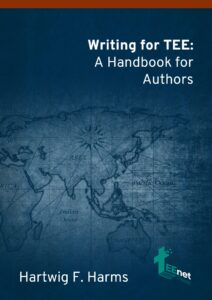TEEnet is pleased to announce the publication of “Writing for TEE: A Handbook for Authors” by Hartwig F. Harms. The title, “Writing for TEE,” signifies the book’s focus on the unique writing style and techniques required for Theological Education by Extension (TEE). The book is available as a free and fully accessible e-book, in line with TEEnet’s vision to encourage open access to theological learning materials. We are grateful to the author and other copyright holders for their willingness to forfeit any royalties and publish the book under a Creative Commons licence. Please click here to download “Writing for TEE“. A hardcover version of the book is also available and sold by TEEnet solely to cover production and shipping costs. Inquiries for purchase of the hardcover version should be directed to [email protected].
“Writing for TEE: A Handbook of Authors” is the 2024 revised version of an early guide by Hartwig Harms on TEE course writing. Course writing, TEE workbook developments and lesson design have been central activities for every generation of TEE practitioners. The TEE handbook is one of the central pillars of TEE as an educational method which allows learners to engage with appropriately designed learning material in their contexts. Hartwig Harms’ book stands in a long and prominent tradition of TEE practitioners reflecting on the pedagogical and practical considerations for course writers as well as sharing best practices.

Hartwig F. Harms has over 50 years of experience in theological education, specifically in TEE. He was part of one of Africa’s oldest, longest-running, and innovative TEE programmes of the Mekane Yesu church in Ethiopia for many years, including leading the programme for five years. He was also heavily involved in multiple regional TEE workshops in the 1980s and 1990s in Africa, which brought together TEE practitioners and course writers from diverse African countries and denominations to be trained in TEE in general and in course writing for TEE specifically. Later, he founded a TEE programme in his own denomination in Germany. Over the years, Hartwig F. Harms regularly returned to Ethiopia, where he continued to be involved in TEE and course writer training.
“Writing for TEE” was initially written as a sequence to the book “Training T.E.E. Leaders: A Course Guide” edited by Margaret Thornton and published by Evangel Publishing House, Nairobi 1990. The former was a book about training group leaders and tutors, while “Writing for TEE” is a handbook for TEE course writers, authors, and trainers of course writers of TEE material. The book grew from 50 years of experience with theological distance education and different types of self-study materials. The content was tested in several workshops to train TEE writers and coordinators.
“Writing for TEE” looks at TEE and especially how TEE then relates to specific course writing for TEE programmes (unit 1). Unit 2 looks at domains (ways) of learning and how they inform TEE course writing. Unit 3 is about levels of learning (facts, insights, applications) and their place in lesson design. Unit 4 explores different formats that have traditionally been used in TEE. This includes: Programmed Instruction (PI), Semi-Programmed Instruction (SPI), workbooks, textbooks, companion study guides, and audio-visual materials. Unit 5 looks at course writing specifically for adult learners. Unit 6 deals with how to choose appropriate subjects/topics. Unit 7 looks at objectives as guides for course writing. Unit 8 looks explicitly at identifying appropriate content for the course and lesson. Unit 9 is about organising notes and ideas. Unit 10 looks at designing daily lessons. Unit 11 is about the art of writing good questions. Unit 12 looks at designing companion study guides. Units 13-15 cover editing, proofreading, testing, evaluations, and revisions. Unit 16 addresses the question of contextualisation of TEE learning materials.
“Writing for TEE” was designed to train TEE writers in Programmed Instruction (PI) and Semi-Programmed Instruction (SPI) methodologies, but its content and details go beyond that. The book is equally useful for course writers of other types of TEE materials and for helping teachers create TEE study guides to accompany existing textbooks. The book guides writers in preparing good teaching material for use in TEE programmes, providing practical tips and strategies for effective course writing.

